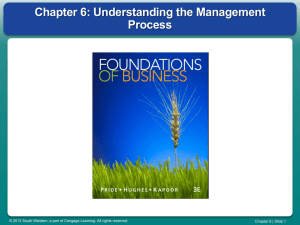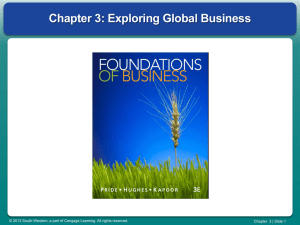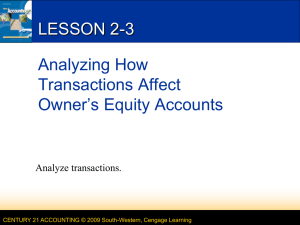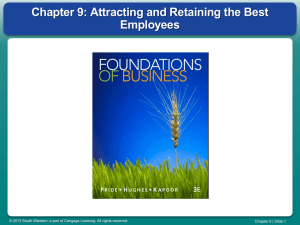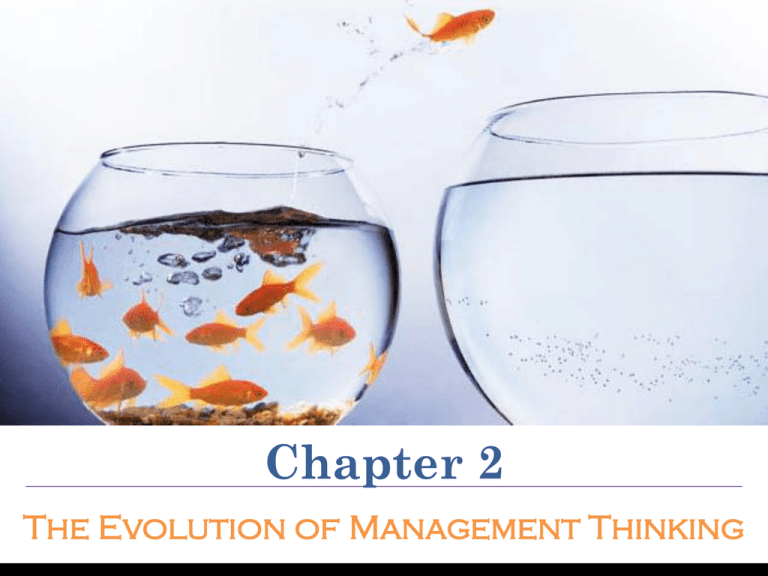
Chapter 2
The Evolution of Management Thinking
2.1 Management Perspectives
over Time
Copyright ©2012 by South-Western, a division of Cengage Learning. All rights reserved.
3
Classical Perspective
• Emerged during the nineteenth and early
twentieth centuries
– Rise of the factory system
– Issues regarding structure, training, and schedule
complex manufacturing operations
Large, complex organizations required new approaches
to coordination and control
• Three subfields: scientific management,
bureaucratic organizations, and administrative
principles
Copyright ©2012 by South-Western, a division of Cengage Learning. All rights reserved.
4
1. Scientific Management
• Improve efficiency and labor productivity through
scientific methods
• Frederick Winslow Taylor proposed that workers
“could be retooled like machines”
• Management decisions would be based on precise
procedures based on study
• Henry Gantt developed the Gantt Chart to measure
and plan work
• The Gilbreth’s pioneered time and motion studies
to promote efficiency
Copyright ©2012 by South-Western, a division of Cengage Learning. All rights reserved.
5
2.2 Characteristics of
Scientific Management
Copyright ©2012 by South-Western, a division of Cengage Learning. All rights reserved.
6
2.Bureaucratic Organizations
• Max Weber, a German theorist, introduced the
concepts
• Manage organized on an impersonal, rational basis
• Organization depends on rules and records
• Managers use power instead of personality to
delegate
Although important productivity gains
come from this foundation, bureaucracy
has taken on a negative tone
Copyright ©2012 by South-Western, a division of Cengage Learning. All rights reserved.
7
2.3 Characteristics of
Weberian Bureaucracy
Copyright ©2012 by South-Western, a division of Cengage Learning. All rights reserved.
8
3.Administrative Principles
• Focused on the entire organization
• Henri Fayol, a French mining engineer, was a major
contributor
• Identified five functions of management: planning,
organizing, commanding, coordinating, and controlling
• 14 general principles of management; many still used
today:
–
–
–
–
Unity of command-receive orders form one superior
Division of work
Unity of direction-group similar activities under one manager
Scalar chain
Copyright ©2012 by South-Western, a division of Cengage Learning. All rights reserved.
9
Humanistic Perspective:
Early Advocates
• Mary Parker Follett and Chester Barnard
• Understand human behaviors, needs, and
attitudes in the workplace
• Importance of people rather than engineering
techniques: contrast to scientific management
• Empowerment: facilitating instead of controlling
• Recognition of the informal organization
• Introduced acceptance theory of authoritychoice to choose to follow or otherwise
Copyright ©2012 by South-Western, a division of Cengage Learning. All rights reserved.
10
Humanistic Perspective: Human
Relations Movement
• Effective control comes from within the
employee than authoritarian control
• Hawthorne studies were key contributor
• Human relations key variable in increasing
performance
• Employees performed better when managers
treated them positively
Copyright ©2012 by South-Western, a division of Cengage Learning. All rights reserved.
11
Humanistic Perspective: Human
Resources Perspective
• From worker participation and considerate
leadership to managing work performance
• Combine motivation with job design
• Maslow and McGregor extended and challenged
current theories
– Maslow’s Hierarchy
– Theory X and Theory Y
Copyright ©2012 by South-Western, a division of Cengage Learning. All rights reserved.
12
2.4 Theory X and Theory Y
Copyright ©2012 by South-Western, a division of Cengage Learning. All rights reserved.
13
Humanistic Perspective:
Behavioral Sciences Approach
• Uses Scientific methods + sociology, psychology,
anthropology, economics…etc to develop
theories on behavior & interaction in
organization
• Organizational Development – field that uses
behavioral sciences to improve organization
• e.g. coping with change, improve internal r/ship,
increase problem solving capabilities
Copyright ©2012 by South-Western, a division of Cengage Learning. All rights reserved.
14
Quantitative Perspective
• Also referred to as management science
• Use of mathematics and statistics to aid
management decision making
– Enhanced by development and growth of the
computer
• Operations Management focuses on the physical
production of goods and services
• Information technology focuses on technology
and software to aid managers
Copyright ©2012 by South-Western, a division of Cengage Learning. All rights reserved.
15
Recent Trends: Systems Thinking
• The ability to see the distinct elements of a
situation as well as the complexities
– The relationship among the parts form the whole
system
• Subsystems are parts of the system that are all
interconnected
• Synergy – the whole is greater than the sum of
its parts
Managers must understand subsystem
interdependence and synergy
Copyright ©2012 by South-Western, a division of Cengage Learning. All rights reserved.
16
2.5 Systems Thinking and
Circles of Causality
Copyright ©2012 by South-Western, a division of Cengage Learning. All rights reserved.
17
Recent Trends:
Contingency View
• Every situation is unique, there is no universal
management theory
• Managers must determine what method will work
• Managers must identify key contingencies for the
current situation
• Organizational structure should depend upon
industry and other variables
Copyright ©2012 by South-Western, a division of Cengage Learning. All rights reserved.
18
2.6 Contingency View
of Management
Copyright ©2012 by South-Western, a division of Cengage Learning. All rights reserved.
19
Recent Trends: Total Quality
Management
• Quality movement is strongly associated with
Japan
• The US ignored the ideas of W. Edwards Deming,
“Father of the Quality Movement”
• Total Quality Management (TQM) became
popular in the 1980s and 90s
• Integrate high-quality values in every activity
Copyright ©2012 by South-Western, a division of Cengage Learning. All rights reserved.
20
Elements of Quality Management
Employee involvement
Focus on the customer
Benchmarking
Continuous improvement
Copyright ©2012 by South-Western, a division of Cengage Learning. All rights reserved.
21

